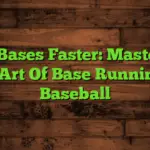In baseball, split-second decisions can mean the difference between a strikeout and a home run. A crucial element in making those quick, accurate decisions is reaction time. This comprehensive guide explores the best baseball drills to improve reaction time, covering everything from fundamental techniques to advanced training methods. You’ll learn how to identify your weaknesses, implement targeted drills, and track your progress, ultimately transforming your on-field performance. We’ll cover various drills suitable for players of all skill levels, from Little League to professional athletes.
Reaction time, in the context of baseball, refers to the time elapsed between the presentation of a stimulus (e.g., a pitch) and the initiation of a response (e.g., swinging the bat). This isn’t simply about speed; it’s about processing information rapidly and efficiently. Factors influencing reaction time include visual acuity,
cognitive processing speed, and neuromuscular efficiency.
Why Improve Reaction Time Matters
Faster reaction time directly translates to more hits, better fielding, and improved overall performance. A quicker reaction allows batters to connect with pitches earlier, giving them a better chance at making solid contact. For fielders, it means more reliably catching fly balls and making quicker throws to bases. Improved reaction time even minimizes the risk of injury by allowing for quicker responses to unexpected movements on the field.
Assessing Your Current Reaction Time
Before diving into drills, it’s crucial to establish a baseline. You can use simple tools like reaction time tests available online or apps. These tests typically involve a visual or auditory stimulus, and the time it takes for you to respond is measured. Regularly tracking your scores provides a benchmark for monitoring progress.
Basic Drills for Beginners: Building the Foundation
For beginners, the focus is on establishing fundamental movement patterns and improving hand-eye coordination. Simple drills such as catching fly balls using various throwing speeds, reacting to a coach’s signals, and practicing quick reflexes with a tennis ball tossed against a wall are excellent starting points.
Intermediate Drills: Increasing Complexity and Speed
As skill progresses, drills can incorporate more challenging elements. This may involve using faster pitches from a pitching machine, incorporating unpredictable throws from a partner, and focusing on specific movements like quick draw drills (batting without the pitch) and precise footwork around the bases.
Advanced Drills for Elite Players: Fine-Tuning and Precision
Advanced drills require a high level of skill and focus. These might include advanced reaction drills with varying pitch types and speeds, performing drills under pressure with time constraints, and analyzing video footage to identify areas for improvement. The focus is on refining technique, improving consistency, and maximizing speed and precision.
The Role of Visual Training in Improving Reaction Time
Visual training plays a critical role in enhancing reaction time. Exercises that improve peripheral vision, tracking ability, and focus are beneficial. These could involve tracking moving objects, practicing peripheral vision exercises, and even using visual training software designed to improve reaction time.
Incorporating Mental Training for Optimal Performance
Mental preparedness is paramount. Mental training techniques such as meditation, visualization, and mindfulness can help reduce anxiety, improve focus, and enhance cognitive processing speed. Regular mental preparation contributes significantly to consistent and improved reaction time.
The Importance of Proper Warm-up and Conditioning
Before engaging in any drills, a proper warm-up is crucial. This prepares the muscles and improves reaction time. Dynamic stretches, light cardio, and specific baseball-related movements enhance both physical and mental readiness. Furthermore, good physical conditioning ensures that the player has the stamina to perform drills effectively.
Utilizing Technology: Reaction Time Training Tools
Several technological tools can enhance reaction time training. Reaction time testing apps, pitching machines with adjustable speeds, and video analysis software provide quantifiable data and detailed feedback to optimize training and identify weak points.
Creating a Personalized Training Program
A successful program is tailored to the individual’s skill level, needs, and goals. Consider conducting a thorough self-assessment, establishing measurable objectives, creating a structured training schedule, and tracking progress over time to refine the plan.
Common Mistakes to Avoid During Training
It’s crucial to avoid rushed movements, improper technique, ignoring rest periods, and neglecting mental preparation. Focus on quality over quantity and strive for consistent performance, not just bursts of speed.
Nutrition and Hydration: Fueling Your Performance
Proper nutrition and hydration are essential for optimal performance. Maintaining a balanced diet that supports both physical and mental well-being and consistent hydration contribute significantly to reaction time and overall fitness.
Tracking Progress and Making Adjustments
Regularly track your performance using reaction time tests and performance metrics. Note down improvement areas and adjust your training plan to address weaknesses and build on strengths. This allows for optimized training and consistent progress.
The Role of Recovery and Rest in Enhancing Performance
Adequate rest and recovery are crucial in optimizing performance. Muscles need time to recover, and mental breaks help prevent burnout and maintain focus. Incorporate rest days into your training schedule and prioritize quality sleep.
Comparing Different Reaction Time Drills: Which One is Best?
There’s no single “best” drill. The optimal choice depends on your current skill level, specific weaknesses, and available resources. A combination of different drills, incorporating variety, is often most effective.
Safety Precautions During Reaction Time Drills
Safety is paramount. Always use appropriate protective gear, ensure proper supervision, particularly when using pitching machines, and practice drills in safe and well-lit environments.
Frequently Asked Questions
What is the best way to improve hand-eye coordination for baseball?
Improving hand-eye coordination involves a multifaceted approach. Regular practice with drills that involve catching and throwing, such as using a tennis ball against a wall, reacting to tossed balls, and focusing on precise movements when catching fly balls, are all helpful. Visual training exercises, such as tracking moving objects, can also significantly improve coordination.
How long does it take to see improvement in reaction time?
The timeline varies based on several factors, including initial skill level, training intensity, consistency, and individual differences. While some improvement can be noticed relatively quickly (within weeks), significant advancements typically take months of dedicated practice.
Are there any physical limitations that might affect reaction time?
Yes. Factors like poor vision, neurological conditions, and certain physical limitations can impact reaction time. Consult with a medical professional if you suspect a physical issue is affecting your performance.
How can I maintain consistent reaction time improvement?
Consistency is key. Regular practice, incorporating diverse drills, and proper recovery are essential for maintaining improvement. Tracking progress, adjusting the training plan as needed, and maintaining a healthy lifestyle further enhances consistency.
Can I improve reaction time beyond a certain age?
While age can impact reaction time, it doesn’t necessarily impose limits. With consistent training and a focus on improving neurological function through drills and mental training, improvements can be made at any age.
What is the ideal frequency of reaction time training?
The ideal frequency depends on individual circumstances and recovery capabilities. Aim for regular sessions, perhaps 2-3 times per week, with sufficient rest periods in between to prevent burnout and allow for proper muscle recovery.
Final Thoughts
Improving reaction time is a journey, not a destination. By consistently applying the drills and techniques discussed in this guide, you’ll significantly enhance your performance on the baseball field. Remember that a holistic approach, incorporating physical training, mental conditioning, proper nutrition, and adequate rest, is crucial for achieving lasting success. Start today, track your progress, and enjoy the rewarding experience of transforming your game. Dedication and consistency are the keys to unlocking your full potential.





